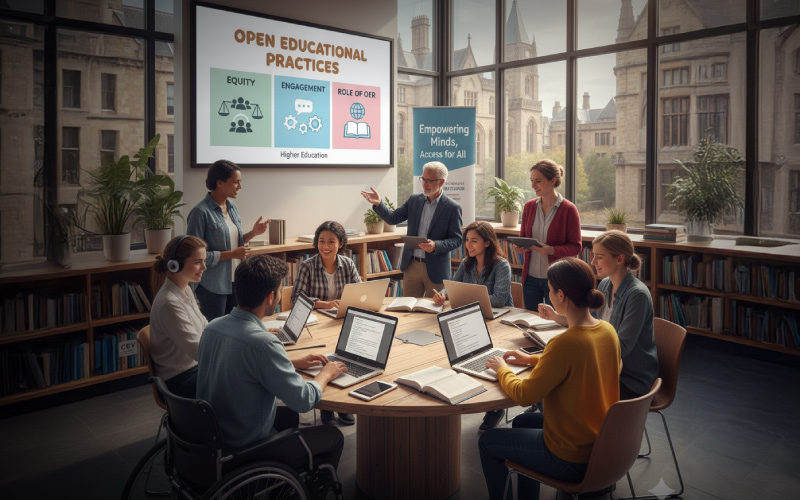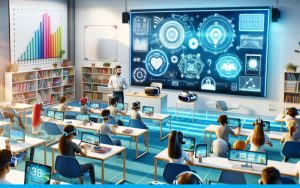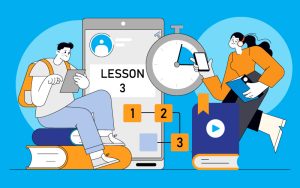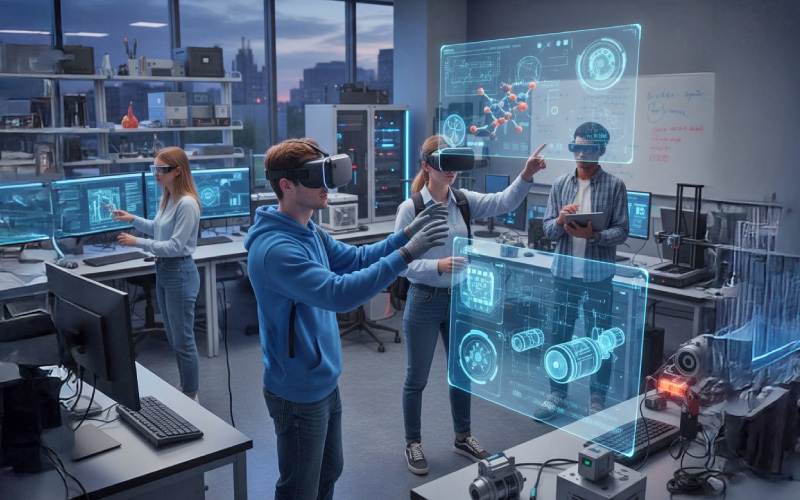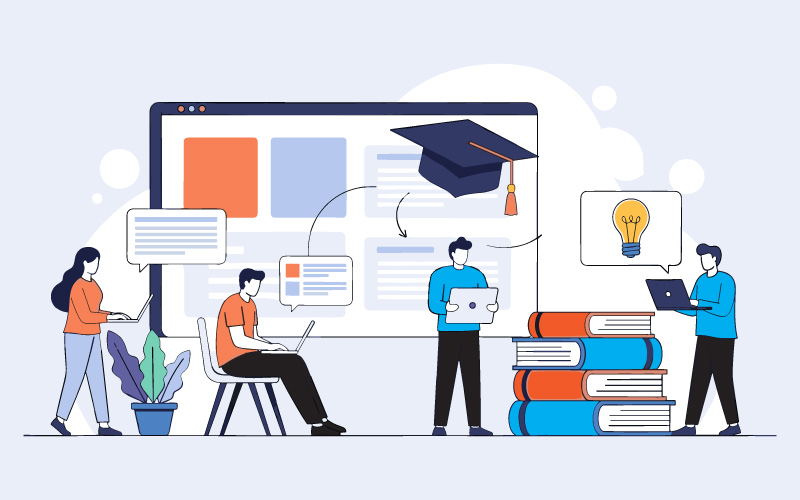Some colleges report that close to half of their first-year students access at least one course without the assigned materials. Cost is usually the reason, though not the only one. A few faculty note that students choose alternatives, rely on shared copies, or skip materials completely.
The pattern says something about access, but also about how learning resources are created and circulated.
When this keeps occurring across different departments, it suggests the issue is not isolated. Materials move through a course in ways the institution does not always follow.
Students piece together what they can, while faculty maintain structures that assume full access. The mismatch becomes visible only when learning outcomes shift in unexpected ways.
That is usually where conversations about open practices begin, not from theory but from noticing gaps that persist semester after semester.

How OEP Changes Course Materials
Institutions maintain long cycles for textbook review, content updates, and instructional planning. The cycles tend to run on their own momentum, and they rarely match the pace at which student expectations move. The gap grows quietly.
This is usually where Open Educational Practices come in. Not a full reset, more of a collection of methods people use to adjust how material moves between instructors, students, and whatever community groups the course touches. The range is broad. Different teams interpret it in their own way, sometimes loosely.
A few points usually stand out:
-
Materials become editable, not fixed, which changes how faculty design around them.
-
Students contribute artifacts that carry academic value.
-
Communities outside the institution are not treated as peripheral.
-
Feedback loops tighten because revision is expected, not exceptional.
None of this guarantees equity or engagement. It only changes the underlying structure. And that shift tends to influence participation patterns over time.
Moving from this structural view, the next question concerns what students actually produce and why their contributions matter beyond demonstration of skill. That leads directly into learner-generated content.

How Student-Created Materials Work Inside OEP
Some programs still treat student-created materials as small, optional components, usually in the form of annotations, glossaries, or brief reflections that stay inside the LMS and fade once the term ends.
These activities technically qualify as learner-generated content, yet they do not capture the broader intent of OEP, which asks whether students contribute to the explanatory structure of a course rather than only adding peripheral pieces.
A few institutions experiment with this by having students rework problem sets, revise case examples, or supply explanatory notes for complex topics.
The process moves slowly because faculty adjust their level of control, and the output varies, though the variation often reveals where conceptual understanding weakens. When students attempt to explain the material, gaps that assessment rarely detects become visible.
Several patterns show why these matters:
-
Student work exposes shortcuts in reasoning that instructors rarely see.
-
Revisions accumulated across cohorts create a record that departments can reuse.
-
Shifts in disciplinary language become easier to track when non-experts engage with it.
As institutions gather these artifacts, they notice changes in how material circulates and how course boundaries loosen, creating a natural path toward community-based course design.

Community Course Design in Practice
Several programs experiment with partnerships that bring coursework into contact with local organizations, often starting with something modest such as a dataset, a policy document, or a narrow operational problem, before expanding into broader collaboration.
This approach aligns naturally with OEP because both rely on open materials, shared authorship, and a willingness to revise content in stages, though community design differs by giving external groups a degree of influence over how a course evolves.
A useful example appears in a university partnership with a regional water board.
Students worked with public data, faculty wove in policy materials that normally sat outside coursework, and the combined activity formed a cycle in which terminology improved, reporting practices shifted, and the course structure evolved each semester.
Patterns tend to emerge over time:
-
Course updates become simpler when source materials remain public.
-
External reviewers focus on clarity instead of budget considerations.
-
Faculty adopt more frequent revision habits rather than waiting for scheduled overhauls.
The arrangement is not without complications, especially when timelines or expectations diverge, yet the ongoing revision culture that forms around these partnerships creates conditions that connect directly to questions of equity, which the next section addresses.

Equity as Practical Access
Equity in most institutions is usually tied to financial relief, accommodations, or targeted support programs.
Within OEP, however, it functions through a different frame that starts with removing licensing barriers, so materials remain accessible without paywalls. It continues into broader questions about who contributes to course content and how different interpretations shape the academic language students encounter.
When students revise materials- or when community groups add contextual pieces, the range of contributors expands in ways faculty can observe across terms.
Shifts in terminology, clarity, and disciplinary framing become more noticeable, which pushes departments toward incremental adjustments. Over time, these small revisions make the course language more usable for a wider set of learners without reducing academic rigor.
Patterns appear in several areas:
-
How long materials remain usable after a course ends
-
How students reenter resources at different stages
-
How openly shared content circulates informally across cohorts
These patterns point toward structural issues rather than sentiment, setting up the need to examine OER as infrastructure, which the next section addresses.

OER as a Working System
OER is often framed as a cost-saving alternative to commercial textbooks, yet it operates more effectively as a working system that shapes how programs design, update, and maintain their course materials, especially when those materials can be revised or combined without licensing delays.
One university’s public policy department illustrated this when it connected two open datasets and shortened its update cycle from months to weeks, which aligned the course more closely with ongoing policy activity and allowed students to work with information that felt current rather than archival.
-
Several considerations recur when OER is treated as a system
-
Materials remain stable even when vendors change
-
Interdisciplinary courses integrate resources with fewer administrative steps
-
Faculty review peer materials without restrictive access protocols
These patterns influence long-term planning and create a foundation for assessment models that incorporate revision, collaboration, and public-facing outputs, which the next section examines.

Assessment in an OEP Setting
Assessment practices shift when OEP becomes part of regular course design. Traditional exams and closed papers still serve their purpose, but they sit alongside tasks that ask students to annotate open texts, produce short explanatory modules, or assemble small cases that connect course ideas to local situations.
These pieces can carry forward into future cohorts, which changes how faculty view revision and reuse. Some instructors question whether openness affects rigor, although in practice, rigor depends more on clear criteria and visible reasoning than on restricting materials.
Pilot projects show that workload patterns change gradually. Early semesters may require more revision, while later terms benefit from accumulated student work that instructors refine rather than rebuild.
Differences across disciplines also become easier to observe once open tasks are in place.
Over time, these shifts create a record of learning that feeds into broader structural decisions, setting up the considerations addressed in the next section.

How Courses Gradually Change
Changes associated with OEP tend to emerge slowly, as departments move through learner-generated materials, community partnerships, and revised assessment models in a steady sequence that is supported by the flexibility of OER.
Over time, programs see resources circulating with fewer barriers, updates negotiated with less delay, and instructional language settling into clearer patterns.
These shifts accumulate across terms and begin to influence how faculty understand course ownership, how students participate in shaping content, and how communities relate to academic work.
The movement is not abrupt, yet it establishes the conditions that bring the broader discussion to its close.
FAQ's
Why is accessibility essential to STEM education for students with special needs?
Accessibility to STEM eLearning means that all students (of both genders and with special needs) get to be partakers of learning programs. It's a step towards eliminating educational inequalities and fostering multiverse innovation.
In STEM education, what are some common problems encountered by students with special needs?
Some common issues are course format that is not complex, non-adapted labs and visuals, insufficient assistive technologies, and no customized learning resources. Besides this, systemic issues such as learning materials that are not inclusive, and teachers who are not trained.
How can accessibility be improved in STEM eLearning through Universal Design for Learning (UDL)?
Through flexible teaching and assessment methods, UDL improves accessibility in STEM content. Also, UDL allows learners to access and engage content in multiple ways and demonstrate understanding of content.
What are effective multisensory learning strategies for accessible STEM education?
Examples of multisensory learning strategies in accessible STEM include when students use graphs with alt-text, auditory descriptions of course materials, tactile models for visual learners through touch, captioned videos for auditory learners, and interactive simulations to allow boys and girls choice in how they have access to physical, visual, auditory, video and written content representation.
Identify the assistive technologies required for providing accessible STEM material?
In order to provide access to STEM material, technologies like screen readers, specially designed input app for mathematics, braille displays, accessible graphing calculators are required.
How can STEM educators approach designing assessments for students with special needs?
To create content for students with special needs, tactics such as creating adaptive learning pathways in more than one format, oral and project assessments and multiway feedback will prove to be beneficial.
What is the role of schools and policymakers in supporting accessible STEM education?
Educational institutions should focus on educating trainers and support staff, also they can invest in assistive technology, and work towards curricular policies.
Can you share examples of successful accessible STEM education initiatives?
Initiatives like PhET Interactive Simulations, Khan Academy accessible learning resources, Labster virtual laboratory simulations, and Girls Who Code’s outreach are examples of effective practice.
How can Mitr Media assist in creating accessible STEM educational content?
Mitr Media is focused on designing and building inclusive e-learning platforms and multimedia materials with accessibility standards in mind so that STEM material is usable by all learners at different levels of need.
What value does partner with Mitr Media bring to institutions aiming for inclusive STEM education?
Mitr Media has expertise in implementing assistive technology, enacting Universal Design for Learning, and providing ongoing support to transformation organizations, enabling their STEM curriculum into an accessible and interesting learning experience.
- Unnati Umarehttps://www.mitrmedia.com/resources/blogs/author/unnati_u/
- Unnati Umarehttps://www.mitrmedia.com/resources/blogs/author/unnati_u/
- Unnati Umarehttps://www.mitrmedia.com/resources/blogs/author/unnati_u/
- Unnati Umarehttps://www.mitrmedia.com/resources/blogs/author/unnati_u/


